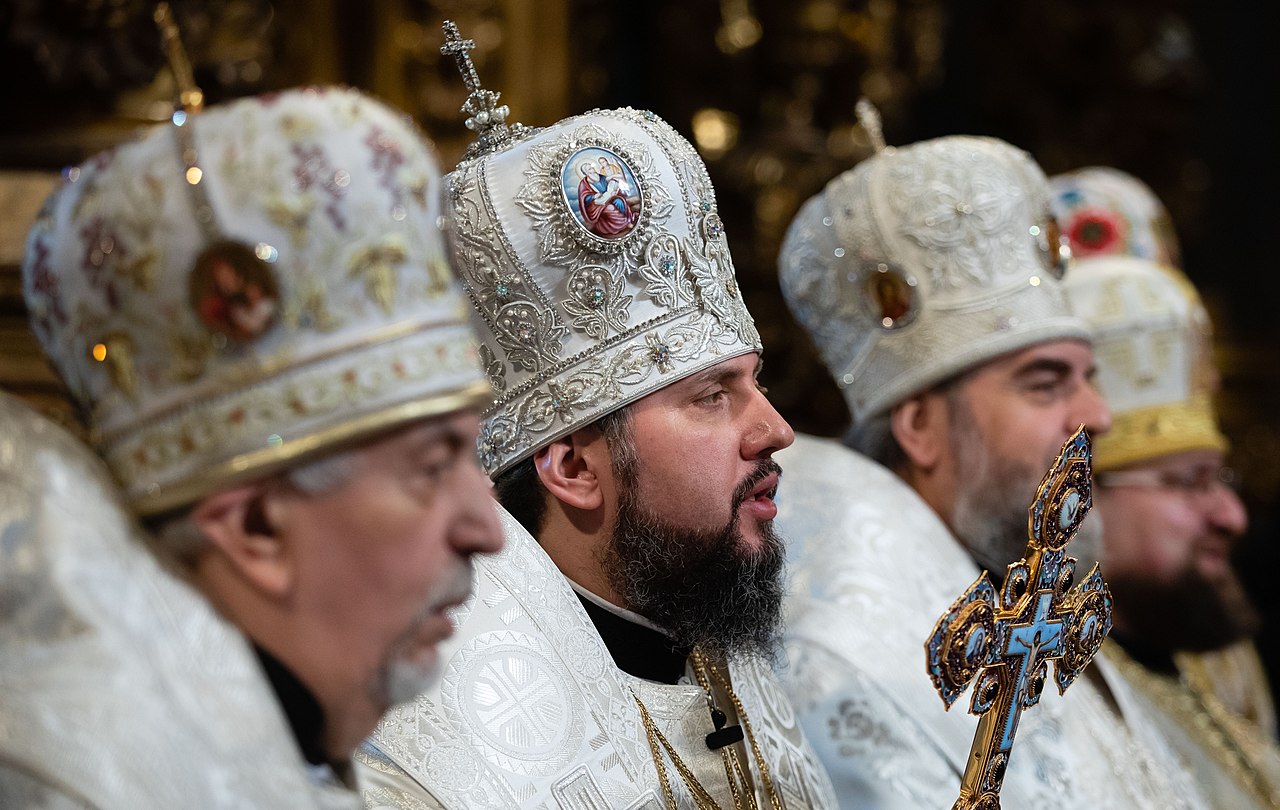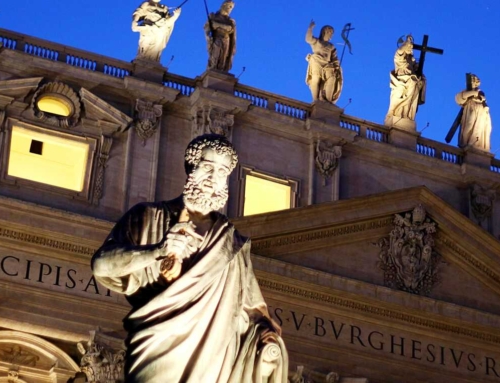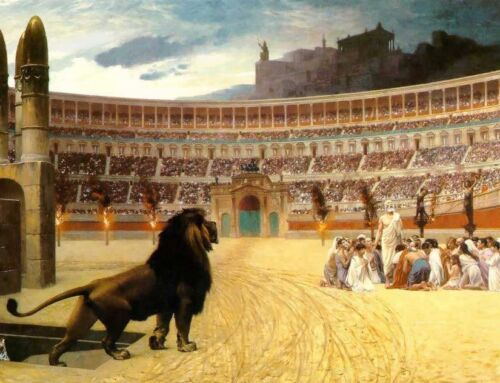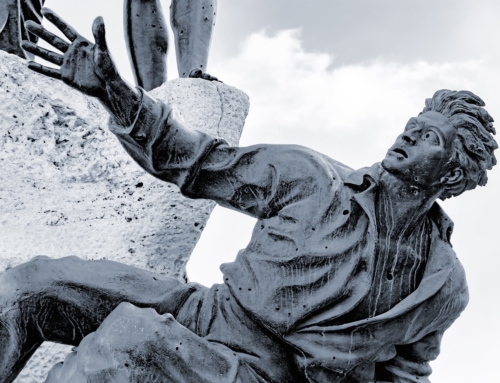A few years ago I had the privilege of standing in the sacristy of a Ukrainian church watching a priest friend of mine prepare for Mass. The wonderful liturgies of the Church’s eastern rites (the Byzantine, Maronite, Ukrainian and others) express a richness and complexity of worship that contrasts with the simplicity of the Roman Rite, so this was a new experience for me.
As I watched Father putting on his vestments one by one, I noticed that he was doing so very deliberately and mumbling something under his breath as he went. His prayerfulness drew me in and everything seemed to get quiet in the room.
Not wanting to disturb his concentration, I silently counted the number of vestments he put on (there were five, in addition to his cassock). I admired how he seemed to tune out all perception of anything else around him, myself included, as he concentrated on the task at hand. It was like I was invisible as he walked by me heading toward the sanctuary.
After the liturgy, I asked him what he was saying under his breath as he donned his robes, and he showed me the book of vesting prayers that Ukrainian priests pray as they put on their liturgical garments before Mass. Father had them all memorized and recited them in the native language of the liturgy, but I was able to read the English translation.
Garments of salvation
The prayers were stunningly beautiful, each having its own biblical references to “garments of salvation”, being “clothed with holiness”, and the like. I had never heard of anything like this before.
Suddenly an old advertising phrase took on an entirely new meaning: the clothes make the man. That was apparent by the way Father seemed to be drawn into the prayer as he put on his vestments one by one. After he was fully vested, he was still my friend, but it was evident that he was God’s friend first.
Another thing occurred to me: the priest’s prayerful involvement in the Mass starts way before the Mass begins. He doesn’t just walk out and wing it before an audience (at least he shouldn’t). He invests himself in the prayer of the Mass even before he walks into church.
In Persona Christi
Praying formulas while putting on garments may be a rote exercise for some priests, but for my friend – and I suspect for countless other good priests – it is their prayerful entryway into a deep mystery that gives life to our life and makes the priest who he is as a servant of God.
The priest is identified with the holy sacrifice of the Mass in a way no other person in the congregation can be. He prays the Mass “in persona Christi” (in the person of Christ) for the sins of the world and the needs of the faithful. The vestments, which are not ordinary clothes used in daily life, are symbolic of his consecration to the work of sanctifying the faithful through the sacred mysteries.
Apparently I had paid little attention to all those references to garments in the Old and New Testaments, but now I noticed them, as if for the first time:
- The vestments of Aaron the high priest (Exodus 28)
- The garments of salvation and the robes of righteousness (Isaiah 61:10)
- The seamless tunic of Jesus which was not torn (John 19:23)
- The “new robes” of the baptized (Galatians 3:27)
- The garments of the Eternal High Priest (Revelation 1:13)
- The robes of the redeemed “made white in the blood of the Lamb” (Revelation 7:14).
“Priests pray when they put on their vestments for Mass,” I marveled. This was an epiphany to me.
The Roman Rite
The next obvious question: Did my Church do that too?
It took only one Google search to find out that I was a latecomer to this reality. Not only are there centuries-old priest vesting prayers in the Roman Rite, but deacons and bishops have them as well. (I was able to find fifteen vesting prayers for a bishop!)
The Roman liturgy is defined by its striving for “noble simplicity” in prayer, so the Roman Rite vesting prayers are generally shorter than those of the eastern churches. They are no less beautiful, particularly when they are recited in Latin (see the video below).
The vesting process (duration 3:49)
For those who would like to see the vesting process of a priest before the Traditional Latin Mass, here is an excellent short video provided by the Fraternity of St. Peter recorded at EWTN’s Shrine of the Blessed Sacrament in Hanceville, Alabama. This video features the Latin version of the prayers.
The vesting prayers in English
Take a moment to read these seven vesting prayers of the priest and pause after each one to let the spiritual reality of the “garment” seep into your soul. Even though a lay person does not dress like this for Mass, these prayers can actually draw anyone into prayer, even while sitting at a computer, because they are symbolic of spiritual preparation for entering into a sacred mystery.
At the washing of the hands (symbolic of inner purification):
Give virtue to my hands, O Lord, and wipe away every stain, that I may be worthy to serve Thee in purity of mind and body. [Pause]
While putting on the Amice (the garment that goes over the shoulders to cover the Roman collar):
Place, O Lord, the helmet of salvation upon my head to repel the assaults of the Evil One. [Pause]
While putting on the Alb (the white robe worn under the vestments):
Purify me, Lord, and cleanse my heart so that, being made white in the Blood of the Lamb, I may merit eternal joys. [Pause]
While putting on the Cincture (the decorative rope that goes around the Alb):
Gird me, O Lord, with the cincture of purity and extinguish my earthly desires, so that the virtues of continence and chastity may dwell within me. [Pause]
While putting on the Maniple (only used in the Traditional Latin Mass; worn on the left arm, symbolizing an instrument of work):
May I merit, O Lord, to bear the maniple of weeping and sorrow in order that I may joyfully reap the reward of my labors. [Pause]
While putting on the Stole (the thin strip of cloth worn around the neck which is the symbol of the priestly authority):
Restore again, O Lord, the stole of immortality, which I lost by the transgression of our first parents, and although I am unworthy to come unto Thy sacred mysteries, grant that I may attain everlasting felicity. [Pause]
While putting on the Chasuble (the outer garment which covers the entire body; its name resembles “casa” or house):
O Lord, Thou who hast said, “My yoke is easy, and My burden is light”, grant that I may so bear Thy yoke as to attain Thy grace. Amen. [Pause]
Soul Work
The priest prays these prayers in silence as he prepares himself to celebrate Mass. His prayerfulness at Mass has a great impact on the spiritual experience of the congregation, and much of that has to do with his preparation before Mass begins.
The priestly vestment prayers highlight the spiritual reality the Church calls a “proper disposition” for receiving grace. The more disposed we are (open-minded and open-hearted), the more effectively God’s grace is able to work in our lives.
That means we need to prepare well for Mass. The priest uses these and other prayers to focus his mind and emotions on the Sacrifice he is about to offer. We can also use them or any of the numerous other “Preparation for Mass” prayers the Church offers us to open ourselves to Christ’s grace.
The purpose of our pre-Mass preparation is not simply to recite prayers but to enter into the mystery beforehand and to make everything other than Christ invisible.




I knew that Russia had some beautiful churches, but the one you discussed made entirely of wood with no nails sound like a miracle. I have heard of a spiral staircase built entirely of wood with no nails constructed by two angels for a group of nuns, Thanks for this inspirational articles about the Church in Russia. I always thought it a tragedy that Russia went communist and formed the nucleus of the Soviet Union. I think, had the bishops responded to the Popes appeal early enough, the world would have a mass conversion greater than the conversion of the Mexicans in 1531. The world would have been incredibly better today if they had.
Thanks Maurice! God brings so much good even out of the evils of Communism. God bless!
Hi everyone! Just desired to drop in and announce some amazing news—I’ve just launched my own drywall repair business right here in stunning California! рџЏ–пёЏ With the ocean breeze in the atmosphere and the sun shining down, there’s absolutely never been a better time to ensure your home’s walls are in top-notch state. Our crew specializes in shoreline properties, so whether you’re handling with wear and tear from the salty air or need some professional repairs after a storm, we’ve got you taken care of. Can’t wait to assist homeowners throughout the coast with their drywall needs! Feel liberated to reach out if you have any questions or required a quote. Let’s preserve those walls looking pristine! рџЉ
This article offers a refreshing and insightful perspective on the outdated notion that a woman’s worth is tied to her culinary skills. The author’s candid reflections challenge traditional gender roles, emphasizing that cooking is a valuable life skill for everyone, regardless of gender. It’s empowering to see such narratives that promote equality and personal choice over societal expectations. A compelling read that encourages readers to redefine what it means to be a “real woman” in today’s world.